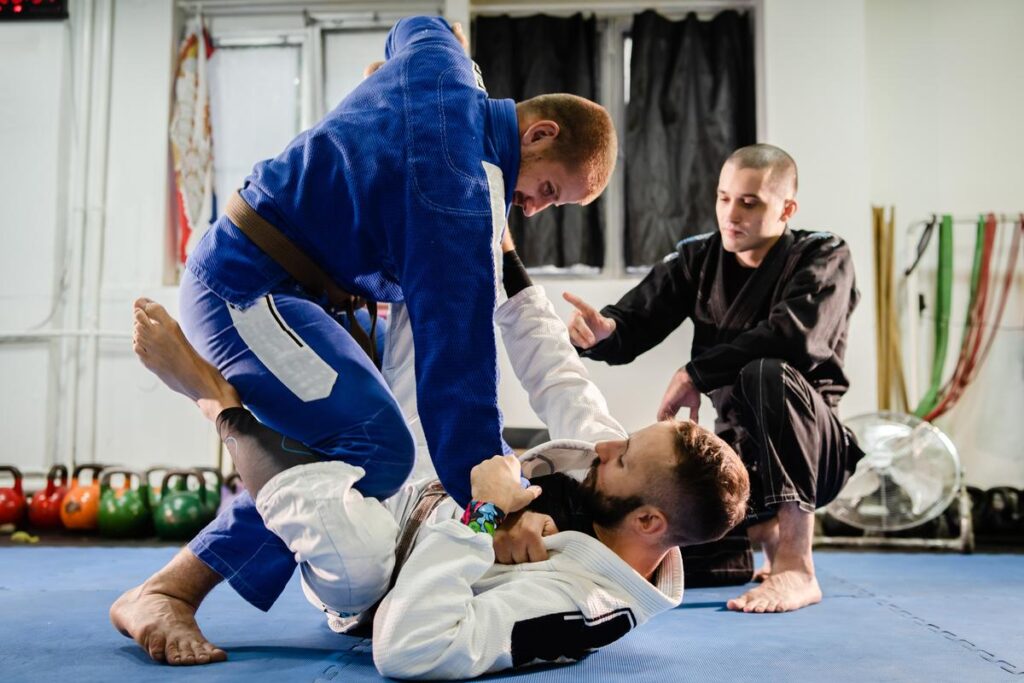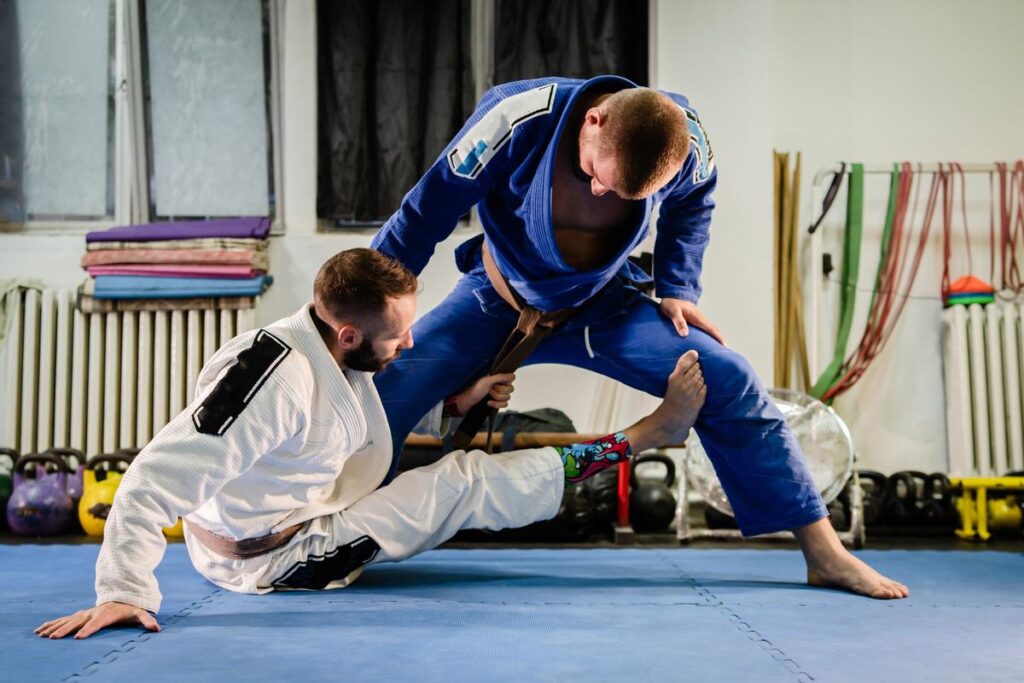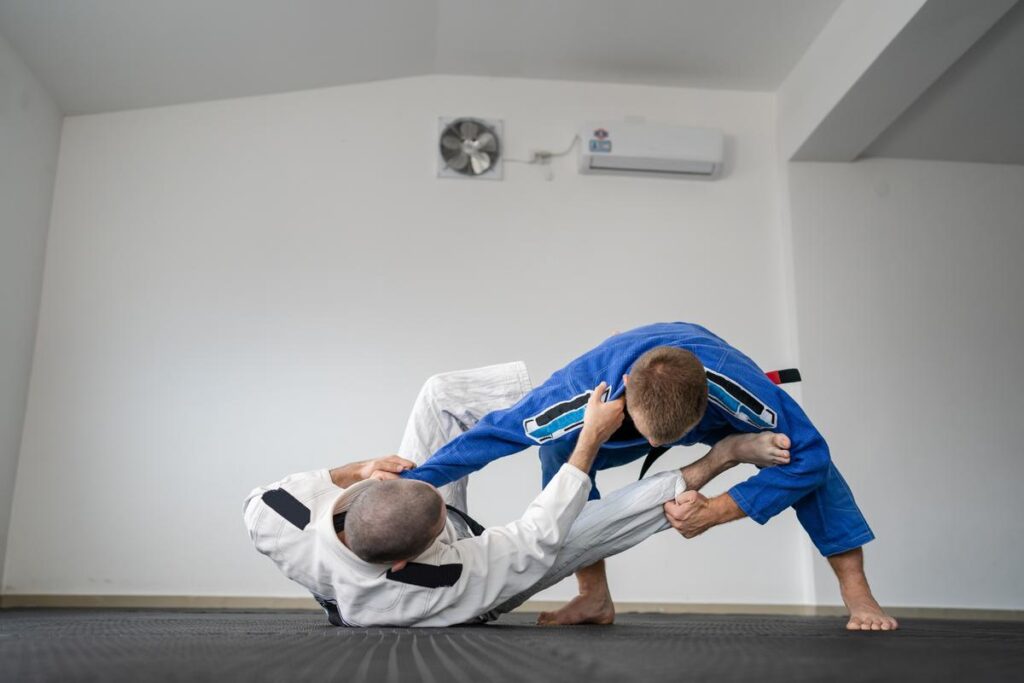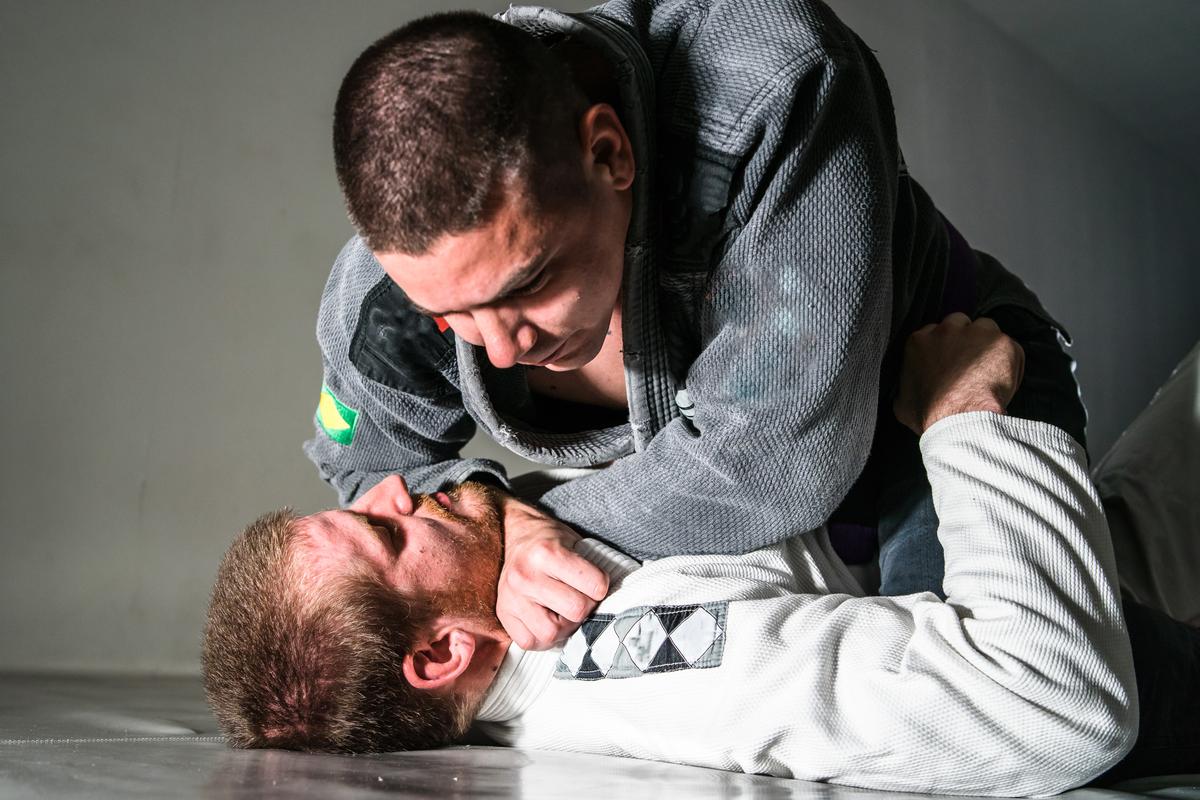The guard position is one of the most fundamental positions taught in Brazilian Jiu Jitsu (BJJ), In this article we will explore “What Is Guard Position In BJJ“
It involves using your legs to control an opponent from the bottom as you work for sweeps, submissions, or escapes. Developing a strong guard game is critical for every BJJ grappler.
In the guard position, the person on bottom uses their legs to control the opponent’s torso or hips.
This allows the bottom grappler to prevent strikes, recover from being taken down, and set up additional techniques.
There are many types of guard such as closed guard, open guard, spider guard, lasso guard, and more. Each variation uses slightly different mechanics to control positioning.
Brazilian Jiu Jitsu originated from Judo in the early 1900s and was refined by the Gracie family into an effective martial art.
BJJ training emphasized ground fighting and submissions. Fights would often end up in the guard position, so developing strong defensive and offensive skills from guard became a cornerstone of BJJ.
Having a dangerous guard meant you could neutralize strikes and size advantages by controlling opponents from your back.
BJJ tournaments then helped evolve complex guard systems. Today, the guard remains one of the most important positions in BJJ due to its versatility and frequency in live training.
How To Improve Half Guard Game BJJ and What Is Guard Position In BJJ, these two topics sometimes make confusion to practitioners, but you don’t need to worry about them because in this article we have covered everything in detail like guard position in bjj and every topic.
Defining the Guard Position
The guard refers to any position where the bottom grappler has their legs wrapped around the hips or torso of their opponent.

Understanding the key elements that characterize the guard is important for proper execution.
Purpose
The main purpose of the guard is defensive. It allows the bottom fighter to remain safe from strikes, recover position if taken down, and set up their own attacks. From guard, the grappler can submit, sweep or stand back up using control of the legs.
Basic Mechanics
In the guard, the bottom grappler must control the opponent’s torso by hooking their legs around them.
The most basic guard position involves placing both legs around the hips or back and squeezing to maintain control. Proper positioning of the legs and hips is fundamental.
Types of Guard
There are three major categories of guard in BJJ:
- Closed Guard: The bottom grappler crosses their ankles together behind the opponent, restricting their movement.
- Open Guard: The bottom grappler hooks their legs around the opponent but their ankles remain uncrossed for more mobility.
- Non-Hooking Guard: The legs control without using traditional hooks, as seen in spider, lasso and de la riva guards.
Understanding these core classifications and mechanics is key for proper execution of the guard in live training and competition.
Advantages of the Guard
The guard provides many integral advantages for the grappler on bottom:
- It acts as a shield against potential strikes and blows on the ground during self-defense scenarios.
- It allows the bottom grappler to control the opponent’s posture, breaking them down to expose vulnerabilities.
- From guard, the bottom grappler can attack with submissions like armbars, triangles and omoplatas.
- The guard enables the bottom fighter to initiate sweeps and reverse position into more dominant positions.
- The guard can provide a moment of rest before resuming attacks, letting the grappler catch their breath.
- Hooking guard retains position after being taken down, allowing the grappler to safely recover their position.
These advantages make developing high level guard skills a vital part of every BJJ practitioner’s game.
Common Mistakes to Avoid
While guard play is critical in BJJ, there are some common mistakes grapplers should avoid:
- Not controlling the opponent’s posture, allowing them to stay upright and rain down strikes.
- Keeping space between the legs rather than staying glued tight to the opponent’s torso.
- Laying flat on the back rather than at a 45-60 degree angle for optimal leverage.
- Allowing grips on sleeves, collars or pants to be broken, losing control.
- Overusing closed guard when open or non-hooking guards may be more effective in some situations.

Being aware of these potential pitfalls will help grapplers improve their overall guard game dramatically.
In summary, the guard remains one of the most important and fundamental positions in BJJ. Understanding its defensive purpose, mechanics and types of guard is key for proper execution. A dangerous guard game is a substantial part of every grappler’s skillset.
Advantages of the Guard
The guard provides many important advantages and benefits for the grappler on bottom:
Allows Control from Bottom Position
The guard gives the bottom grappler the ability to control their opponent through their legs hooked around the hips or torso.
This disrupts their opponent’s balance, posture and positioning even from underneath. The guard facilitates attacking, defending, sweeping or escaping from the bottom.
Enables Sweeps and Submissions
From guard variations like de la Riva and spider guard, the bottom grappler can execute pivotal sweeps to reverse or take the back against their opponent.
For example, off-balancing and elevating with the legs makes completing sweeps simpler.
Likewise, the control over posture facilitated by the guard enables submissions like armbars, triangles and omoplatas to be set up and finished. Without guard control, completing these pivotal techniques would be extremely difficult.
Critical Skill for BJJ Self-Defense
For self-defense purposes, the guard is vital to negate size, strength and striking disadvantages against larger attackers.
From guard, a smaller defender can control an aggressive opponent, mitigating blows until they can escape safely to the feet or counterattack. Developing strong guard retention and control skills is essential for BJJ used in real world altercations.
Foundation for Many Other Techniques

Guard skills establish the foundation for many other critical techniques used in live training and competition.
For example, having solid open guard skills makes leg pummeling easier for passing into dominant positions.
Effective closed guard facilitates setting up sweeps, chokes and triangles. Strong guard recovery enables safe retention of position after being taken down. Developing fundamental guard skills improves every area of the BJJ practitioner’s game.
For these reasons, the guard remains one of the highest percentage and most strategically critical positions in Jiu-Jitsu.
It is likely the first line of both defense and attack most grapplers learn, for very good cause. No BJJ player can be considered truly well-rounded or dangerous without an effective guard game.
Developing Strong Guard Skills
Here are some of the best tips and practices for developing high level guard skills:
Drill Guard Retention Intensively
Drilling guard retention techniques like grip fighting, breaking posture and regaining closed guard after it’s passed should be practiced extensively until reactions become instinctual. Controlling skilled training partners from the bottom during intense rounds starts by drilling fundamentals.
Attack from Guard Frequently
Guard players should focus on aggressively submitting training partners from the top positions of their guard during live rolling, especially with triangle chokes, armbars and omoplatas. Developing a dangerous guard means being able to finish from it against resistance.
Chain Positions and Attacks Together
Once fundamental attacks like armbars are learned, string sweeps and submissions together into sequences that flow coherently. For example, transition from de la Riva to deep half guard to the back rather than working in isolation. Create systematic guard games.
Spar Against Larger Training Partners
While drilling is key, developing guard skills also requires testing them against intense resistance. Using guard against much larger training partners prepares smaller grapplers to control bigger opponents from their back. Getting smashed intensifies guard knowledge quickly.
Study Advanced Open Guard Variations
Closed guard skills provide the initial foundation, but studying more sophisticated open guards via online instructionals accelerates learning. Spider guard, de la Riva variations, lapel guards and 50/50 guards offer advanced control and submission options.
Compete Frequently
Nothing tests guard skills more than using them in competitions against unknown opponents. The intensity and adrenaline of tournaments reveals weaknesses in guard games that may not appear in regular training. Competing often expands comfort levels.
By drilling basics, chaining techniques together, attacking from the bottom, and testing skills against resistance, grapplers can craft a guard game that is difficult for any opponent to neutralize over time.
Common Mistakes to Avoid When Passing Guard
While the guard provides advantages for the bottom grappler, it also presents challenges that must be overcome when passing guard. Some common mistakes include:
Not Controlling Posture and Grips
When trying to pass guard, posture and grip control are key. Standing too tall with arms reaching allows the guard player control. Stay low with elbows tucked without reaching to avoid giving up advantages.
Moving Too Far Away
Creating too much space opens the door for strong guard players to move their hips, regain control and re-pummel their legs back in guard. Staying tight inside the legs takes away space. Beware of crafty open guards.
Forcing a Pass Without Isolating Hips
Good guard passing relies on isolating the bottom player’s legs so they can’t recapture guard. Blindly forcing knee slides without isolating and controlling hips first will often fail. Prevent recapturing guard.
Dropping Both Shoulders Forward
Posturing with both shoulders dropped forward when pressing forward catches beginners in triangles. Keep one shoulder high posting when stepping through to avoid this mistake.
Not Having a Strong Base
It’s vital to stay out of open guards by having a solid base with head up, hips down and feet underneath. Playing top without a strong base lets the bottom regain leverage. Strong posture sets up passes.
Trying Too Many Different Passes
Pick 2-3 highly effective guard passes like leg drags and X-passes to perfect. Master a few essential passes rather than getting sloppy at many under pressure. Depth beats breadth when passing guard.
Mastering these basic principles helps avoid common pitfalls when trying to smash through guards in training and competition.
Tips for Passing the Guard
Passing the guard is challenging against skilled opponents. Here are fundamental tactics and concepts to help smash through guards consistently:
Posture Up and Break Grips
Posture by aligning the spine straight, tucking the elbows in, and driving the head and chest upwards. Stiff arms make it harder for opponents to control grips. Strip away collar ties and sleeve grips by peeling fingers back. Strong posture negates the guard player’s control.
Manage Space Intelligently
Proper space management maintains pressure when needed or creates distance when beneficial. When passing, stay tight and pressed into the opponent to take away space. When needing a reset, quickly back out of range where legs can’t reconnect. Press right back into guard recovery attempts.
Isolate Hips Before Knee Passes
Prior to any knee pass attempts, isolate and control the hips first with staples or leg drags. Prevent them from recapturing guard by nullifying hip mobility. Passing legs depends on first controlling the hips.
Place Knees on Floor If Needed
Get both knees down to build a strong base when momentum stalls. Kneeling lowers the center of gravity and takes away the guard player’s leverage. Catch your breath in a low sturdy stance before resuming upward pressure.
Lift Knee at Angle, Not Straight Through
When stepping over legs, lift the knee at an angle rather than straight through their guard. Go over hips on a curve, staying tight to their thighs before sliding through. This traps the leg being passed.
Drill Just a Few High Percentage Passes
Stick with 2-3 highly efficient passes like over-under, leg drag and double under and drill them relentlessly rather than getting sloppy at many. Ingraining just a few money passes pays dividends.
Wrapping Up On “What Is Guard Position In BJJ“
The guard remains one of the most critical positions in Brazilian Jiu-Jitsu, providing excellent control and attacks. However, passing the guard is also a pivotal skill. Implementing intelligent posture, grip fighting, distance management, targeting the hips, and mastering a select few highly reliable passes helps overcome even the craftiest guard retention. Along with attacking from guard, BJJ competitors must practice guard passing and retention diligently to become complete grapplers. Drill both sides of guard skills profusely.

2 thoughts on “What Is Guard Position In BJJ”
Comments are closed.